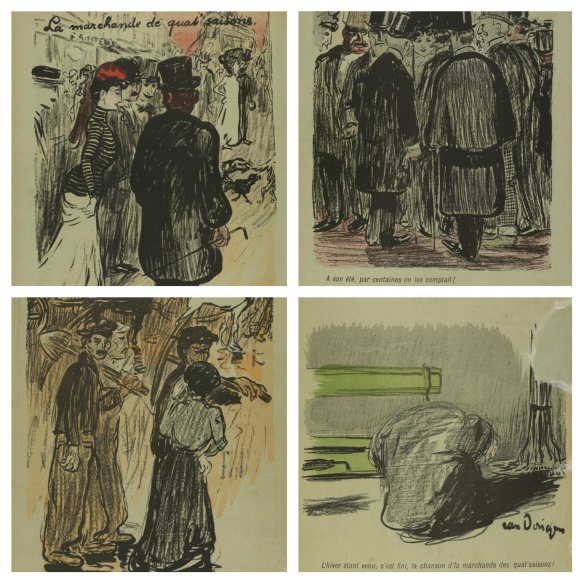Following my previous post on illustrated newspaper supplements, I was looking at some other examples of illustrated press around 1900.
One of the more fascinating publications, artistically and politically, was L’ Assiette au Beurre. This weekly satirical magazine had themed issues in which graphic artists gave their vision of politics and society. During its existence the periodical commissioned many well-known artists who were drawn to its anarchist, anti-authoritarian and socialist politics. Most of the artwork is striking, though not always very subtle and at times quite cynical. Yet the magazine tackled many socio-political issues and taboo subjects.
Dutch born artist Kees van Dongen – he later became a French national – was invited to illustrate a special issue of 26 October 1901 on prostitution. See the whole issue here on Gallica.
Kees van Dongen was familiar with the subject. The son of a factory worker, he left home at 18 and rented a room above a brothel in Rotterdam. In Paris he lived in Montmartre where some of the prostitutes shared his bed, posed for him or paid for the young Dutchman’s meals because they thought he was so handsome. At least according to Van Dongen. Though he would become one of Paris’ richest portrait painters and a prominent society figure after the First World War, Kees van Dongen spent his formative years working night shifts in Les Halles and boxing for money on the Place Pigalle while pursuing his artistic career. At the time, doing illustration work was a great way to make money and to build a reputation. Before moving to Paris Kees van Dongen had already worked as a reporter-illustrator for the Rotterdamsche Nieuwsblad.
Van Dongen would also illustrate Het rosse leven en sterven van de Zandstraat, a best-selling book by Dutch journalist M.J. (Marie Joseph) Brusse on the rosse buurt, the red light district, of Rotterdam. Brusse attempted to show the realities of life in prostitution without the usual moralising. The book’s second edition (1917) –for those who read Dutch – is freely available here and well worth a read for its vivid, often enthusiastic portrayal of a life in the margins that Brusse opposes to the stuffy hypocrisy of the bourgeoisie. Brusse’s book as well as L’ Assiette au Beurre reflect the radical politics and social reform movements of the early 20th century, drawing attention to the underlying causes of prostitution such as poverty. As Brusse writes in his introduction: ‘you can’t blame women for turning to a profession where they are paid a lot more than a maid or a factory worker.’

Illustrations by Kees van Dongen for M.J. Brusse, Het rosse leven en sterven van de Zandstraat, 1917 (2nd edition)
Of course, these are all visions of prostitution through the eyes of others. The women themselves don’t really get a voice. Van Dongen’s illustrations for L’ Assiette au Beurre are a bit sentimental and his drawing of a naked, stretched out, dead cocotte is stereotypical if not exploitative -the magazine had to sell copy after all. Yet ultimately Van Dongen’s illustrations do side with the prostitutes: he shows the crippling shame of an illegitimate child, the threat of illness, death, and the vicious circle of poverty. L’ Assiette au Beurre was clear in its critique of a society that gave women very few choices and then condemned them for it.
Note: Details on Kees van Dongen’s life are taken from Rudolf Engers, Het kleurrijke leven van Kees van Dongen, Schiedam, Scriptum, 2002.




